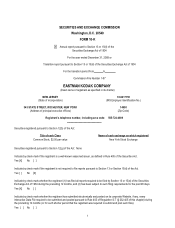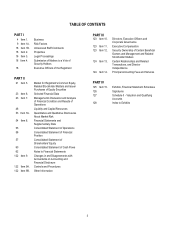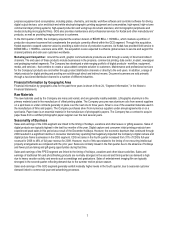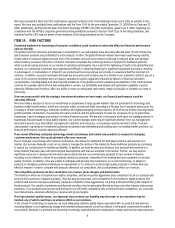Kodak 2009 Annual Report Download - page 12
Download and view the complete annual report
Please find page 12 of the 2009 Kodak annual report below. You can navigate through the pages in the report by either clicking on the pages listed below, or by using the keyword search tool below to find specific information within the annual report. 10
in technologies occur, the occurrence of defects may increase, particularly with the introduction of new product lines. Although we
have established internal procedures to minimize risks that may arise from product quality issues, there can be no assurance that we
will be able to eliminate or mitigate occurrences of these issues and associated liabilities. Finding solutions to quality issues can be
expensive and we may also incur expenses in connection with, for example, product recalls and warranty or other service
obligations. We may also face lawsuits if our products do not meet customer expectations. In addition, quality issues can impair our
relationships with new or existing customers and adversely affect our brand image, and our reputation as a producer of high quality
products could suffer, which could adversely affect our business as well as our financial results.
If we cannot continue to license or enforce the intellectual property rights on which our business depends, or if third
parties assert that we violate their intellectual property rights, our revenue, earnings, expenses and liquidity may be
adversely impacted.
We rely upon patent, copyright, trademark and trade secret laws in the United States and similar laws in other countries, and non-
disclosure, confidentiality and other types of agreements with our employees, customers, suppliers and other parties, to establish,
maintain and enforce our intellectual property rights. Despite these measures, any of our direct or indirect intellectual property rights
could, however, be challenged, invalidated, circumvented, infringed or misappropriated, or such intellectual property rights may not
be sufficient to permit us to take advantage of current market trends or otherwise to provide competitive advantages, which could
result in costly product redesign efforts, discontinuance of certain product offerings or other competitive harm. Further, the laws of
certain countries do not protect proprietary rights to the same extent as the laws of the United States. Therefore, in certain
jurisdictions, we may be unable to protect our proprietary technology adequately against unauthorized third party copying,
infringement or use, which could adversely affect our competitive position. Also, because of the rapid pace of technological change
in the information technology industry, much of our business and many of our products rely on key technologies developed or
licensed by third parties, and we may not be able to obtain or continue to obtain licenses and technologies from these third parties at
all or on reasonable terms.
We have made substantial investments in new, proprietary technologies and have filed patent applications and obtained patents to
protect our intellectual property rights in these technologies as well as the interests of our licensees. There can be no assurance that
our patent applications will be approved, that any patents issued will adequately protect our intellectual property or that such patents
will not be challenged by third parties.
The execution and enforcement of licensing agreements protects our intellectual property rights and provides a revenue stream in
the form of up-front payments and royalties that enables us to further innovate and provide the marketplace with new products and
services. There can be no assurance that such measures alone will be adequate to protect our intellectual property. Our ability to
execute our intellectual property licensing strategies, including litigation strategies, such as our recent legal actions against
Apple Inc. and Research in Motion Limited, could also affect our revenue and earnings. Additionally, the uncertainty around the
timing and magnitude of our intellectual property-related judgments and settlements could have an adverse effect on our financial
results and liquidity. Our failure to develop and properly manage new intellectual property could adversely affect our market positions
and business opportunities. Furthermore, our failure to identify and implement licensing programs, including identifying appropriate
licensees, could adversely affect the profitability of our operations.
In addition, third parties may claim that we, our customers, licensees or other parties indemnified by us are infringing upon their
intellectual property rights. Such claims may be made by competitors seeking to block or limit our access to digital markets.
Additionally, in recent years, individuals and groups have begun purchasing intellectual property assets for the sole purpose of
making claims of infringement and attempting to extract settlements from large companies like ours. Even if we believe that the
claims are without merit, the claims can be time consuming and costly to defend and distract management’s attention and resources.
Claims of intellectual property infringement also might require us to redesign affected products, enter into costly settlement or license
agreements or pay costly damage awards, or face a temporary or permanent injunction prohibiting us from marketing or selling
certain of our products. Even if we have an agreement to indemnify us against such costs, the indemnifying party may be unable to
uphold its contractual obligations. If we cannot or do not license the infringed technology at all, license the technology on reasonable
terms or substitute similar technology from another source, our revenue and earnings could be adversely impacted. Finally, we use
open source software in connection with our products and services. Companies that incorporate open source software into their
products have, from time to time, faced claims challenging the ownership of open source software and/or compliance with open
source license terms. As a result, we could be subject to suits by parties claiming ownership of what we believe to be open source
software or noncompliance with open source licensing terms. Some open source software licenses require users who distribute open
source software as part of their software to publicly disclose all or part of the source code to such software and/or make available
any derivative works of the open source code on unfavorable terms or at no cost. We have a corporate open source governance
board to monitor the use of open source software in our products and services and try to ensure that none is used in a manner that
would require us to disclose the source code to the related product or service or that would otherwise breach the terms of an open
source agreement. Such use could inadvertently occur and any requirement to disclose our source code or pay damages for breach
of contract could be harmful to our business results of operations and financial condition.
























